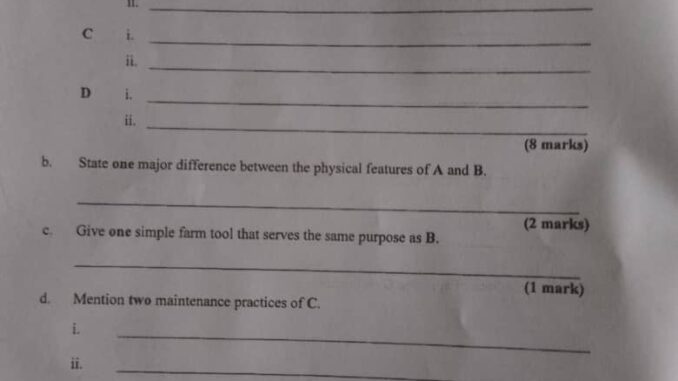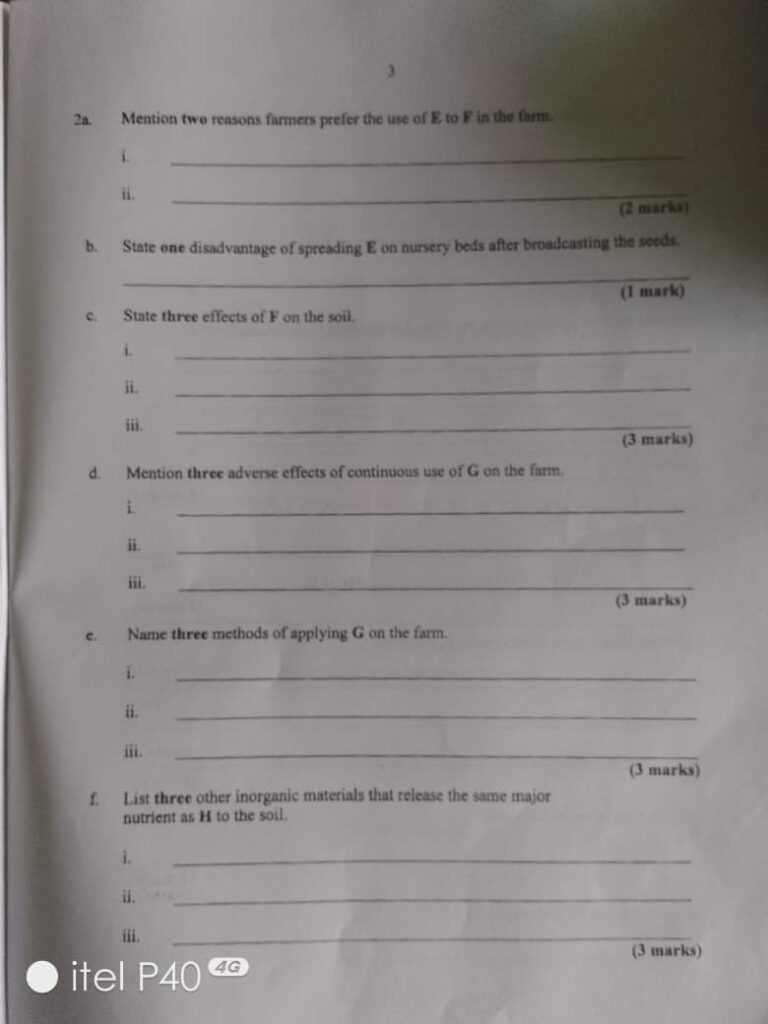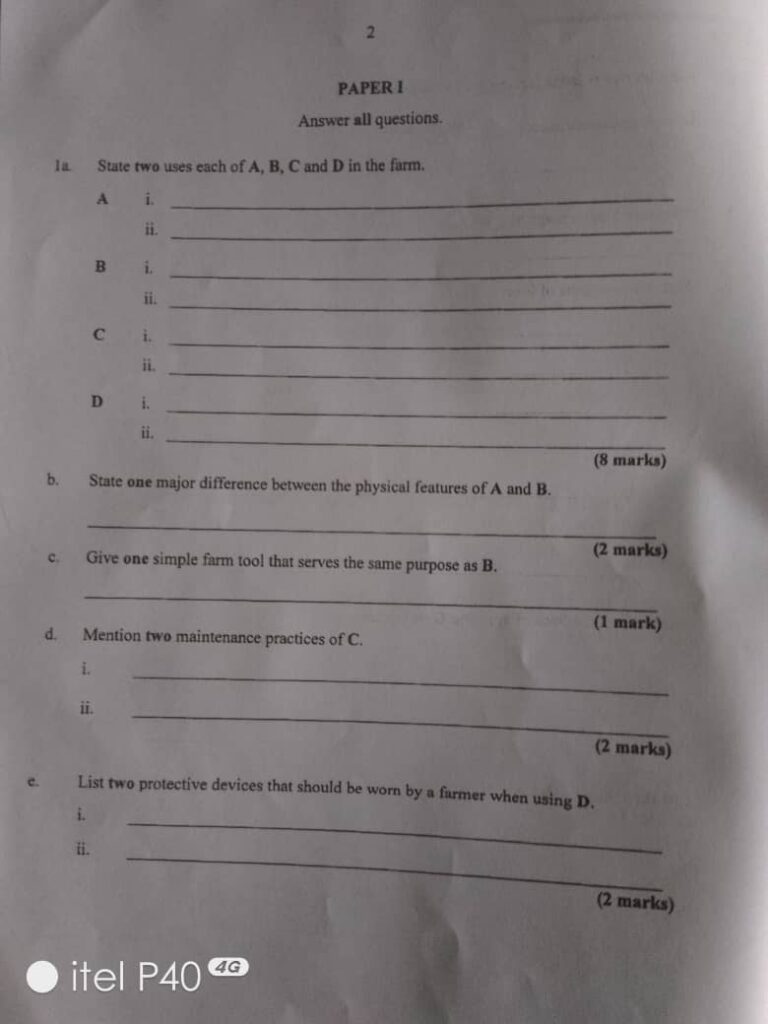
2024 NECO AGRIC-SCI-PRACT-QUESTIONS ;-ExamgrandComNg




2024 NECO AGRIC-SCI-PRACT-ANSWERS;-ExamgrandComNg
(1a)
=Specimen A(Hand Fork):
(i) Loosening soil in gardens and flower beds
(ii) Aerating soil around established plants
=Specimen B (Garden Fork):
(i) Turning over soil in preparation for planting
(ii) Breaking up clods and compacted soil
=Specimen C (Hand Trowel):
(i) Scooping and moving small amounts of soil or fertilizer
(ii) Planting seedlings and bulbs
=Specimen D (Knapsack Sprayer):
(i) Applying pesticides and herbicides to crops
(ii) Spraying fertilizers and water on plants
(1b)
Specimen A(Hand Fork) has shorter tines and a smaller head, making it suitable for lighter work in smaller areas, while Specimen B (Garden Fork) has longer tines and a larger head, making it better suited for heavier work in larger areas.
(1c)
Spade
(1d)
(i) Cleaning the trowel after each use to prevent rust and bacterial growth
(ii) Storing the trowel in a dry place to prevent damage to the handle and metal
(1e)
(i) Gloves
(ii) Goggles
==================================
(2a)
(i)Higher nutrient content: Poultry droppings have a higher nutrient content compared to cow dung, making them a more effective fertilizer.
(ii)Faster decomposition: Poultry droppings decompose faster than cow dung, making the nutrients available to plants more quickly.
(2b)
(i)Burning of young seedlings: Poultry droppings can be too hot for young seedlings and can cause burning or scorching, leading to poor germination and growth.
(2c)
(i)Improves soil structure: Cow dung helps to improve soil structure, making it more conducive for plant growth.
(ii)Increases soil fertility: Cow dung adds nutrients to the soil, increasing its fertility and ability to support plant growth.
(iii)Supports beneficial microbes: Cow dung provides a food source for beneficial microorganisms in the soil, promoting a healthy soil ecosystem.
(2d)
(i)Soil degradation: Continuous use of N.P.K Fertilizer can lead to soil degradation, reducing its fertility and structure.
(ii)Water pollution: N.P.K Fertilizer can leach into water sources, causing pollution and harm to aquatic life.
(iii)Soil acidification: N.P.K Fertilizer can acidify the soil, reducing its pH and making it less conducive for plant growth.
(2e)
(i)Broadcasting: Spreading the fertilizer evenly over the soil surface.
(ii)Banding: Applying the fertilizer in a narrow band along the planting row.
(iii)Fertigation: Applying the fertilizer through irrigation water.
(2f)
(i)Gypsum
(ii)Dolomite
(iii)Calcium nitrate
=================================
No 3

(3a)
=Specimen I (Onion Bulb): Allium cepa
=Specimen J (Yam Tuber): Dioscorea spp. ( various species)
=Specimen K (Cassava Tuber): Manihot esculenta
=Specimen L (Ginger): Zingiber officinale
(3b)
=Specimen I (Onion bulb); Bulb division
= Specimen J (Yam Tuber): Stem cuttings or setts
= Specimen K (Cassava Tuber): Stem cuttings
= Specimen L (Ginger): Rhizome cuttings
(3c)
(i) Yam beetles
(ii) Yam nematodes
(3d)
(i) Peeling and grating the tubers
(ii) Fermenting the grated cassava for 2-3 days
(iii) Frying the fermented cassava to produce garri
(3e)
Onion (Specimen I): Biennial plant (completes its life cycle in two years)
(3f)
It is used to treat various ailments such as nausea and digestive issues.
=============================
(4a)
(i) Host of N. Tapeworm: Pig
(ii) Host of O. Roundworm: Chicken
(iii) Host of P. Tick: Cattle
(4b)
(i)Spec N; Proper disposal of animal waste
(ii)Spec O; Regular cleaning and disinfection of living quarters
(iii)Spec N; Avoiding undercooked meat and raw animal products
(4c)
(i)Refrigeration
(ii)Freezing
(iii)Smoking
(4d)
(i)Body shape: Tapeworms are long and flat, while Roundworms are cylindrical and rounded.
(ii)Body covering: Tapeworms have a tough, outer covering called a cuticle, while Roundworms have a smooth, outer layer.
(4e)
(i)Tick fever (Babesiosis)
(ii)Redwater disease (Babesia spp.)






Be the first to comment